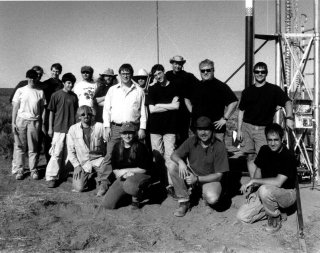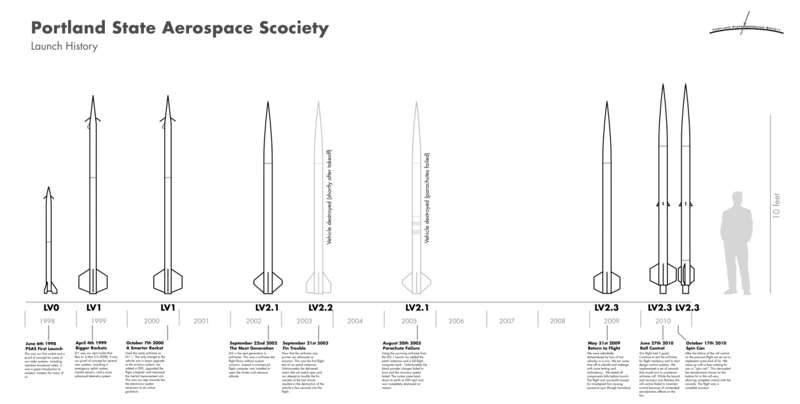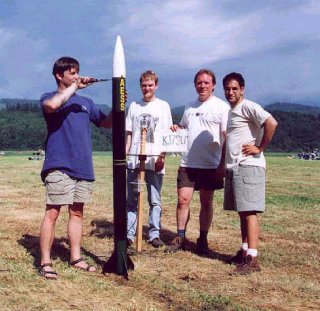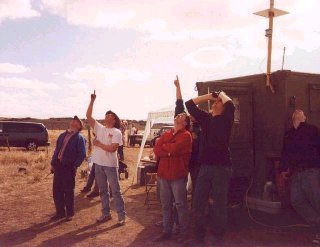
...the Portland State University Branch of the IEEE Aerospace and Electronics System Society (AESS)
(a society of the Institute for Electrical and Electronics Engineers)
What is PSAS?
The Portland State Aerospace Society (PSAS) is an educational aerospace project at Portland State University in Portland, Oregon. The group consists of undergraduate and graduate students, faculty and staff of PSU, and local community members—ranging from high school students to engineers in industry—who are interested in aerospace engineering.
PSAS is based out of the College of Engineering and Computer Science at PSU, and has members and advisors in the Electrical and Computer Engineering, Computer Science and Mechanical Engineering departments.
What are your goals?
Our vision statement—or long term goal—is to “put nanosatellites into orbit”. That's an absurdly hard undertaking when you consider the technical, logistical and financial issues involved. So although we will probably never get there, having this goal allows us to ask the question, “what’s the first step in the process?”
We decided that the first step towards orbiting nanosatellites is to develop an inexpensive, highly modular and actively guided sounding rocket. Sounding rockets are small to medium-sized rockets that are "suborbital"—meaning they can reach extreme altitudes, but then fall down back to the Earth (i.e., they don't go into orbit). Sounding rockets are useful for scientific research in such fields as astronomy, earth science, materials science, and of course, in engineering.
Our rockets fall into the class of “amateur rocketry”—smaller than commercial rockets, larger than model rockets. We certainly have not build the biggest or highest altitude amateur rocket, but we do hope that we're building one of the most sophisticated.
We're focusing in four main areas:
Avionics
Avionics are the computer “brains” of the rocket. We're trying to be one of the first amateur groups in the world to make an actively guided rocket—i.e., a rocket that is autonomously guided by an on-board computer. Technically speaking, we're hoping to build an amateur DGPS-aided inertial navigation system.
Airframe
We're working on modular airframe sections to reduce the weight and cost of the rocket while increasing adaptability. Airframe sections are easily swappable, as are the fins and skin. Technically speaking, we're hoping to push our mass fraction up as high as possible—beyond 60% for a single stage vehicle—while still maintaining robustness.
Our current airframe is still heavy, and is being used as a simple test-bed for the avionics. We are now in the beginning stages of designing a next-gen light airframe to start pushing the mass-fraction boundaries.
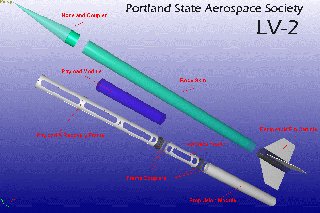
Propulsion
Propulsion's mission is to develop the hardware for vectored thrust. We are developing a ~50 lbf liquid kerosene and oxygen thruster.
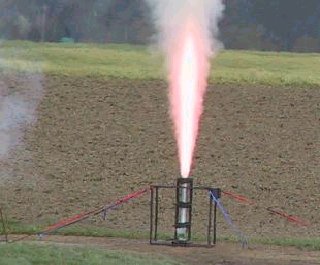
Ground
Since our launch sites and times are dictated by the FAA and the whims of the weather, our ground systems are designed to be as mobile and flexible as possible. The ground systems include the launch tower, launch control module, Communications, Software, and logistical equipment.
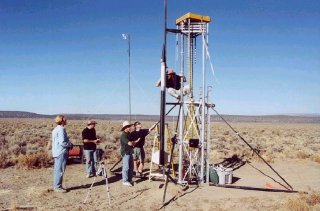
What have you done so far?
We've successfully launched a number complete rocket systems so far:
Launch Vehicle No. 0 (LV0) - 1998
This was our first launch in June of 1998 to 366m (1,200ft). It was our first rocket and a proof of concept for some of our radio systems, including real-time broadcast video. It was a great introduction to amateur rocketry for many of us.
Launch Vehicle No. 1 (LV1) - 1999
LV1 was our next rocket that flew in April of 1999 to 3.6km (12,000ft). It was our proof of concept for several new systems, including a emergency uplink system, inertial sensors, and a more advanced telemetry system.
Launch Vehicle No. 1b (LV1b) - 2000–2
LV 1b used the same airframe as LV1 and flew in October of 2000 to 3.53km (11,600ft). The only change to the vehicle was a major upgrade to the avionics system: we added a GPS, upgraded the flight computer and improved the inertial measurement unit. This was our step towards the the electronics system necessary to do active guidance.
Launch Vehicle No 2 - 2003–present
LV2 is our current generation vehicle. It has a modular design and a robust, redundant, dual deploy system and lots of room for electronics. We have launched this airframe several times. Unfortunately our 2005 launch resulted in a complete loss of the vehicle. Since then we have rebuilt the airframe with a few upgrades and resumed flying in 2009. We continue to innovate, adding a roll control module for our flight in June 2010. We will hopefully re-integrate our earlier full avionics stack and then move on to bigger, lighter airframes and a yet more advanced flight computer before 2011.
We also try and reach out to the community as much as possible. We're a regular attendee at OMSI's Space Days, we've done many educational presentations to local middle and high schools, and we're strong advocates of cross-discipline engineering projects at Portland State.
What are your current projects?
We are still working with LV2. We have successfully launched and the airframe as a hardware test (in addition to several previous launches of the same design). Each subsequent launch includes a new piece to test as we push the envelope of "amateur" rocket systems. LV2 project variants include active roll control and spin-can flights. We are now starting to think larger and more complex; with projects involving staging and guidance in the works.
Are you sharing all of these developments?
You bet. All projects we do are open source, from our CAD drawings to schematic diagrams to our software. We pride ourselves in sharing what we learn with the world of amateur rocket enthusiasts, and with our ability to collaborate with other groups.
Can I get involved?
Absolutely! We need the help! We're looking for anyone who is interested in rocketry or engineering. There are thousands of problems to tackle, ranging from stoachastic control theory to airframe design to computer programming to logistics support. Contact us, or drop in on a meeting, and we'll introduce you to the project and let you decide where you want to fit in! Here's a quick blurb for NewMembers.
If you represent an organization interested in supporting our group, please contact us about Donate. A huge thanks to our Sponsors, without whom we'd have never made it this far.
Do you have more information available?
This site contains all of the information we have on our project. We do have printed materials available for donors, press, and potential payload developers; please Contact us if you're interested.
If you would like to keep up with the major developments in our group, there is a moderated mailing list that's open to the public. We'll be posting major announcements such as launch events, grants won, etc. (think "press releases"): you can sign up at http://lists.psas.pdx.edu/mailman/listinfo/psas-announce.
